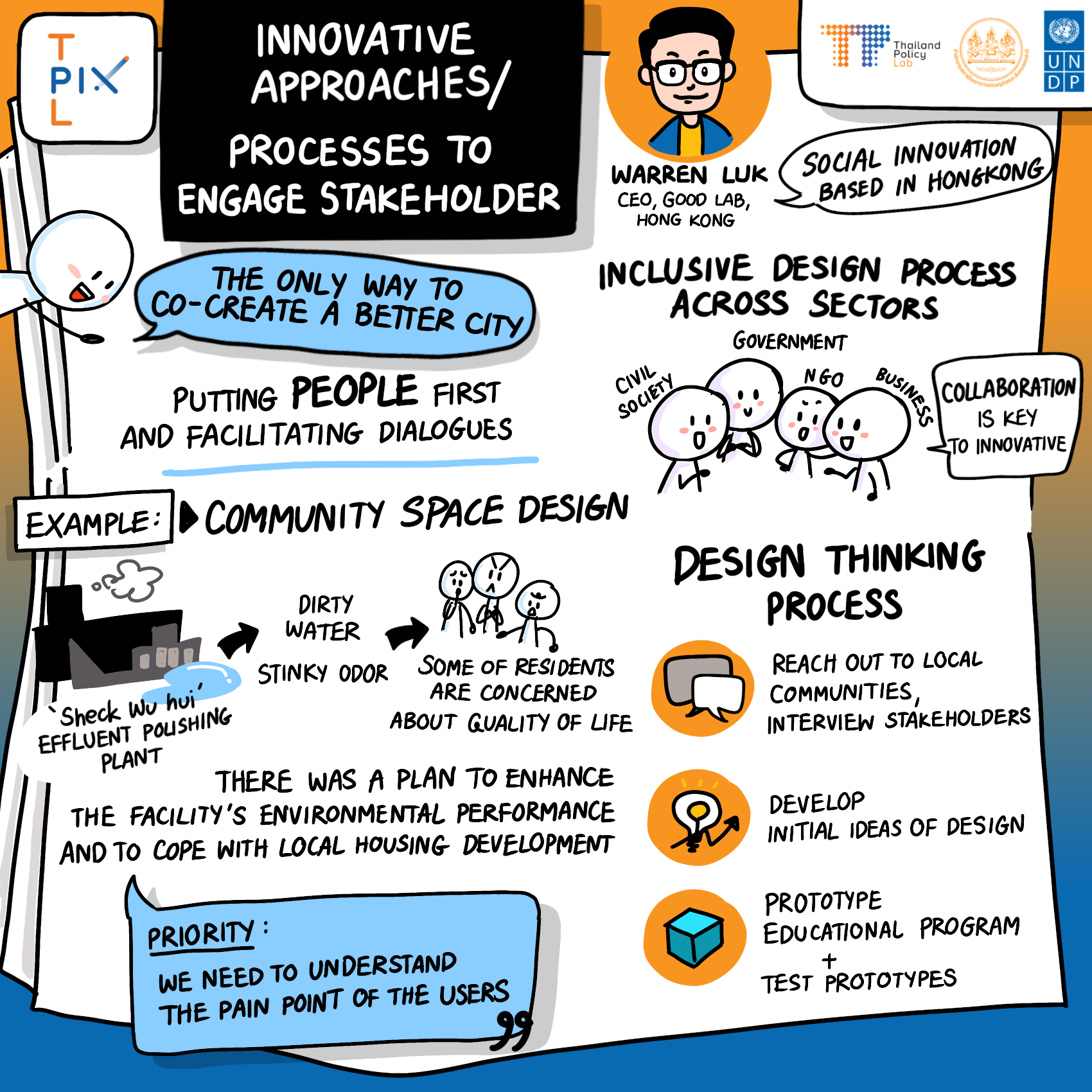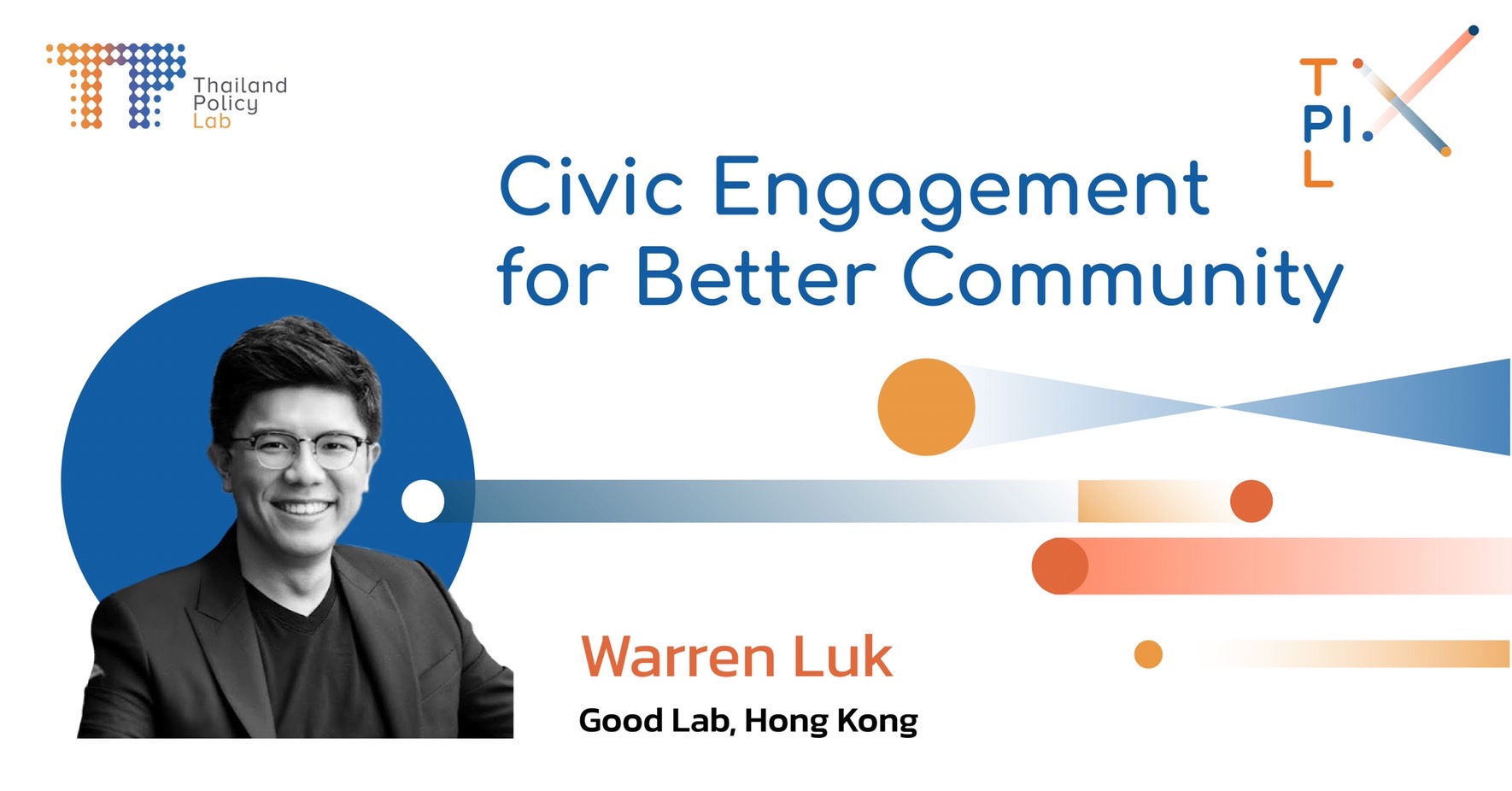The Policy Innovation Exchange saw contributions from some of the world’s leading minds in areas of policymaking and innovation and was held on 24 November 2021. As an event of many firsts—the first event in Thailand to bring global leaders to discuss policymaking, the first event to engage stakeholders from a number of sectors in policymaking—Warren Luk, CEO of Good Lab Hong Kong, provided a thorough explanation with ample evidence of his and his team’s approach to stakeholder engagement.

Good Lab, Hong Kong – Background and Key Activities
Good Lab Hong Kong (GL), is a non-profit organisation founded in 2012, that provides Hong Kong with innovative services, runs several innovation programmes, and acts as an engagement hub for large-scale projects. Since its founding in 2012, GL has consistently adopted and delivered projects which adhere to principles of human-centric engagement and design thinking. For Hong Kong, this has been demonstrated, time and time again, to be the best way to ensure that all sectors are engaged, and that solutions wrought from this process genuinely reflect the needs and values of those involved. Their projects, while many and varied, orient themselves towards empowering communities to co-create with a large network of government institutions, NGOs, and private sector stakeholders.
“Since its inception GL puts people first,” Warren stated, as a mere glimpsing through their portfolio of previous works reveals that the majority of projects are geared to engaging and empowering communities and giving a voice to the people. In addition to social and public sectors, their brand of co-creation focuses on bring together cross-sector collaborations to brainstorm, design, and bring together projects which reflect the needs of all. According to Warren, “We put people first to facilitate dialogues, the DNA of our work, as we believe this is the only way to co-create a better city.”
The People First: Community Engagement – Shek Wu Hui Plant
Close to GL’s inception in 2012, Warren and his team were approached by community members and government officials who found themselves at an impass. While relevant government officials sought to repurpose/refurbish the Shek Wu Hui Effluent Polishing Plant (Shek Wu Hui), the community members of Sheng Shui felt that their voices were not being heard, and were displeased with the fact that the Shek Wu Hui may be established in their community. At this juncture, GL entered the scene to facilitate community and government co-creationin one of the most unique places imaginable, a sewage treatment facility in Sheng Shui, Hong Kong.
Many of the community members expressed concern of the proximity of the plant, as it could possible lower their qualities of life due to odors and the other unpleasantries associated with such services, something which Warren calls the limbic syndrom. This information and more was gathered by Warren and his team over the course of hundreds upon hundreds of interviews conducted with the community members. This, according to Warren, represents an important moment when conducting appropriate stakeholder engagement in policy design, as without creating a touch point with the community, policy directions can easily become misguided. Their thorough incorporation of the end-users of this new project allowed authorities more than simply feedback from the community, it allowed them to engage the community and co-create amicable solutions. “We wanted to find a way to find an answer which wasn’t built on comprimise. We wanted to co-create a facility which people would want, and people would like to live by.”
To remedy this situation, Good Lab embedded themselves into a network which brought together socially minded businesses (architecture businesses, design consultants, etc.), civil society, and the government to facilitate an inclusive design process. All members of this group were invited to take part in the Design Thinking model that GL adopted for this project, which comprised three main phases:
- Empathise
During this phase all stakeholders were invited to help brainstorm which schools, green groups and other communities should be integrated into the process in order to gain a more holistic understanding of the project itself and identify community pain points and exchange knowledge.
- Define – Ideate
As the pain points and experiences of the community became clear, all stakeholders were invited to develop initial community space design ideas. Here, Warren warns that there should be no ‘wrong answers’, as all concerns, ideas, comments, and feedback allow other stakeholders to realise the experiences of others.
- Prototype – Test
During this phase, a district-wide educational programme was launched by the community for the community, allowing stakeholders to see how designed elements are received and integrated into the community itself.
From the beginning of the project with a maligned vision and some level of animosity between stakeholders, to the results obtained after their unique 12-month journey, the community and the departments involved in this project were afforded the chance co-create a facility which more closely reflects the needs of the community, while still maintaining the service uses required by the governement. Accoridng to Warren, this is the aim of public-sector innovation, to empower users, or in this case the community, to achieve something which answers their needs.
Good Lab’s Method: Engage, Learn, Co-Create
During his oration, Warren walked the audience through yet another inspiring example of how GL envisages engagement, which demonstrated that even in online spheres, there are many tools and methods to approach users of policy. Be it through field work, interviews, analysis of online data, co-creating prototypes with legos, or otherwise the takeaway from Warren’s projects are clear: each project presents policymakers and designers with a unique opportunity to co-create something new and democratise processes through stakeholder engagement promoting ownership thereof.
Having dedicated years of experience and 6-months of intense consideration, their model, the Social Innovation Model, has been applied in a number of unique settings with a diverse and unique set of stakeholders, all of whom have benefited from being engaged, learning together, and co-creating their futures. Chosing to close with an African proverb, “If you want to walk fast, go alone. But if you want to walk far, walk together” Warren reiterates the importance of approaching complex and uncertain situations with a sense of collective solidarity. This sense of solidarity is something which stands to benefit policumaking processes, as it allows policymakers and civil society to engage one another, understand one another, and accomplish goals with a collaborative spirit and a sense of co-ownership.

